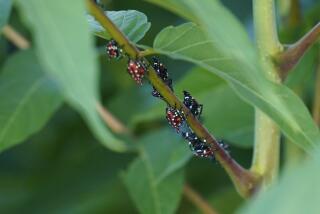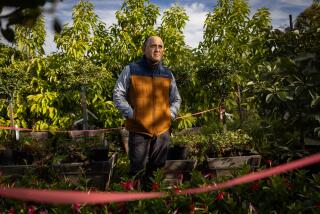Ways to Battle the New Pest in Town
- Share via
Question: Can you offer any advice on how to deal with the whiteflies that are decimating so many hibiscus?
--A.C., Los Angeles
Answer: We’ve received dozens of letters and e-mail on the new giant whitefly that has finally hit town, after starting in San Diego in 1992. It’s been leapfrogging around the southern half of the state and is now found in Ventura County and even San Luis Obispo County.
The “giant” whitefly is actually pretty small, about 3/16 of an inch long. But it makes a big mess, covering leaves with white, waxy deposits and dripping waxy filaments that look like white beards or holiday flocking. Black sooty moot fungus quickly follows, living on the whiteflies’ excrement.
The whitefly dines on a long list of plants--from acacia to xylosma--but favors hibiscus. It’s also found on giant bird of paradise, orchid tree, banana, mulberry, xylosma, even eucalyptus.
Two parasitic wasps have been imported from Mexico and are being released. It is suspected that one or both may eventually bring this whitefly under control.
In the meantime, it pays to keep careful watch on the garden because the pest is fairly easy to control if you act fast.
Colonies tend not to fly or wander around (they drift into your garden on the wind) but cluster on the undersides of leaves. Simply picking off the leaves, putting them in a plastic bag and sending them to the dump will often eliminate the whiteflies.
If they have already become too numerous for that simple technique, the best control is to blast them off the undersides of leaves with the garden hose. University of California tests have shown that this works just as well as chemical treatments, and spraying with poisons may kill off beneficial insects that are helping to check the population.
One reader reports that she has successfully controlled the giant whitefly by blasting them off two times a week.
This advice could apply to any whitefly. Poisons seldom work because the whiteflies recover so quickly. It’s better to stop using poisons and wait until natural predators get the upper hand.
*
Q: I live about nine blocks from the ocean and need to know how to plant asparagus and artichokes.
--T.O., Redondo Beach
A: At this time of year, asparagus and artichokes are most often sold as bare-root starts. Artichokes are planted simply by putting them in the ground at the same level they were before they were dug from the fields. In other words, so the crown and cut-back leaf stalks are just above the soil line.
You live in the perfect spot for growing artichokes in Southern California--close to the beach. But don’t expect the same tasty, meaty buds you find at the market that come from the foggy fields of Castroville up north. Down here, harvest them small and they’ll taste better and be less stringy.
Artichoke plants need average watering and little fertilizer, will produce buds in spring, which should be cut to the ground after harvesting, and will produce a second crop in summer or fall. They will produce a second crop even if you don’t cut them down--though they get quite large--but some people prefer to leave the lovely silvery foliage. In late fall, however, it’s best to cut plants completely back.
Watch out for snails and ants on artichokes.
Asparagus are reliable in all climates, but ask 100 expert gardeners how to plant them and you’ll get 100 answers. These roots are buried underground. One of the most common methods is to plant them in trenches two to four feet apart. Trenches should be 1 foot deep and 1 foot wide with a layer of completely done compost on the bottom.
Space roots about a foot apart and cover them with 2 inches of soil, gradually adding more as the tips begin to grow, until the trench is filled in. Don’t get ahead of the growing tips; make sure they are always exposed.
Asparagus need only normal watering and the compost should feed them for most of the year, although you can fertilize through spring and summer. Add compost on top the following spring.
Plants will produce edible spears for years and years, but don’t harvest any during their first spring. Next spring you can begin harvesting by cutting spears below ground with a forked asparagus knife (also makes a great weeder). Harvest only for a short time and let the rest turn into stalks. Cut this foliage to the ground in late fall.
Got a burning question about a plant, pest or gardening in general? Send it to Garden Q&A;, Southern California Living, Los Angeles Times, Times Mirror Square, Los Angeles, CA 90053, or fax your question to Garden Q&A;, (213) 237-4712, or e-mail it to socalliving@latimes.com. We cannot answer questions individually, only in print.






